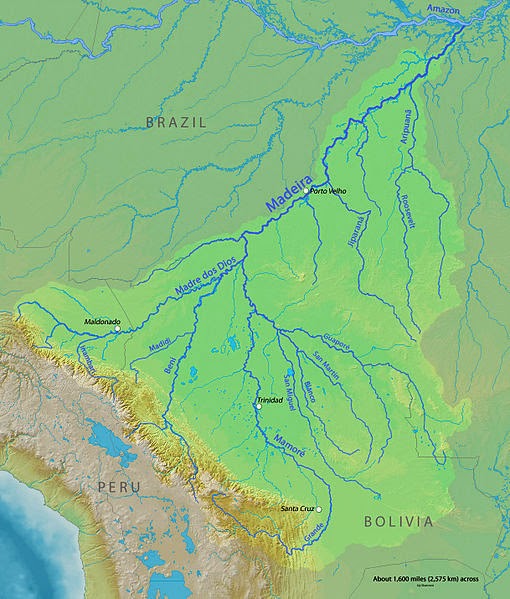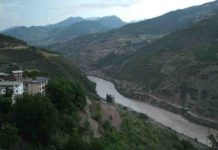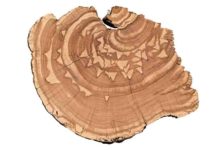
The Madeira River is a major waterway in South America, approximately 3,250 km (2,020 mi) long. The Madeira is one of the biggest tributaries of the Amazon. A map from Emanuel Bowen in 1747, held by the David Rumsey Map Collection, refers to the Madeira by the pre-colonial, indigenous name Cuyari:
“The River of Cuyari, called by the Portuguese Madeira or the Wood River, is formed by two great rivers, which join near its mouth. It was by this River, that the Nation of Topinambes passed into the River Amazon.”
Climate
The mean inter-annual precipitations on the great basins vary from 750 to 3,000 millimetres (30 to 118 in), the entire upper Madeira basin receiving 1,705 millimetres (67.1 in). The greatest extremes of rainfall are between 490 to 7,000 millimetres (19 to 276 in). At its head, the Madeira on its own is still one of the largest rivers of the world, with a mean inter-annual discharge of 18,000 cubic metres per second (640,000 cu ft/s), i.e. 536 cubic kilometres (129 cu mi)/yr, approximately half the discharge of the Congo River. The mean inter-annual contribution of the Bolivian Andes is 4,170 cubic metres per second (147,000 cu ft/s), i.e. 132 cubic kilometres (32 cu mi)yr, representing 25% of the discharge of the entire upper Madeira basin. On the further course towards the Amazon, the mean discharge of the Madeira increases up to 31,200 cubic metres per second (1,100,000 cu ft/s).
Course
Between Guajará-Mirim and the falls of Teotônio, the Madeira receives the drainage of the north-eastern slopes of the Andes from Santa Cruz de la Sierra to Cuzco, the whole of the south-western slope of Brazilian Mato Grosso and the northern slope of the Chiquitos sierras. In total, the catchment area is 850,000 km2, almost equal in area to France and Spain combined. The waters flow into the Madeira from many large rivers, the principal of which, (from east to west), are the Guaporé or Itenez, the Baures and Blanco, the Itonama or San Miguel, the Mamoré, Beni, and Mayutata or Madre de Dios, all of which are reinforced by numerous secondary but powerful affluents. The climate of the upper catchment area varies from humid in the western edge with the origin of the river’s main stem by volume (Río Madre de Dios, Río Beni) to semi arid in the southernmost part with the andine headwaters of the main stem by length (Río Caine, Río Rocha, Río Grande, Mamoré).
All of the upper branches of the river Madeira find their way to the falls across the open, almost level Mojos and Beni plains, 90,000 km2 (35,000 sq mi) of which are yearly flooded to an average depth of about 3 feet (0.91 m) for a period of from three to four months.
The falls of Teotônio and of San Antonio exceed the more famous Boyoma Falls in Africa by volume and total drop. From these rapids, the Madeira flows northward forming the border between Bolivia and Brazil for approximately 100 km (62 mi). Below the confluence of the Rio Abunã, the Madeira meanders north-eastward through the Rondônia and Amazonas states of north west Brazil to its junction with the Amazon. At its mouth is Ilha Tupinambaranas, an extensive marshy region formed by the Madeira’s distributaries.
Note : The above story is based on materials provided by Wikipedia










